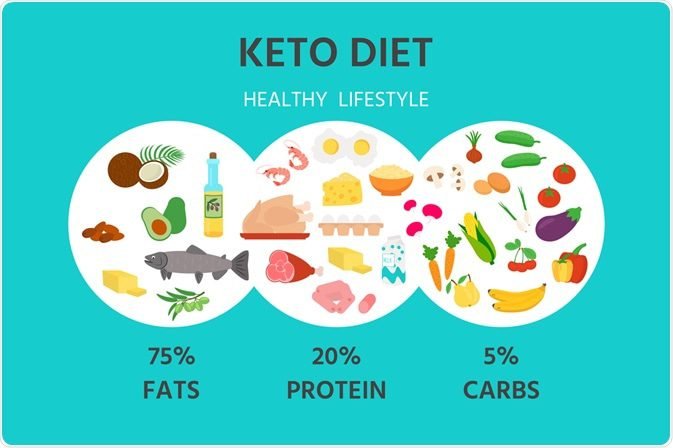A Cyclical Ketogenic Diet (CKD) is a dietary strategy involving periodic carb-loading phases within a primarily ketogenic eating plan. This diet alternates low-carb ketogenic days with higher-carb refeed periods.
The CKD appeals to those seeking a balance between the rigorous fat-burning ketosis state and the flexibility to include carbs occasionally. Diaz designed for athletes and bodybuilders who need to replenish glycogen stores for intense workouts, CKD provides a structured approach to ensure energy availability without exiting ketosis for extended periods.
It requires strict adherence to low-carb intake for a majority of the week, followed by a short term, strategic intake of carbohydrates. This method not only helps in maintaining exercise performance but also aids in muscle recovery and growth. With controlled carb refeeds, CKD may make a ketogenic lifestyle more sustainable and palatable for those who find it difficult to completely renounce carbs.
The Cyclical Ketogenic Diet, A Rhythmic Approach To Low-carb Eating
The Cyclical Ketogenic Diet introduces a dynamic twist to traditional low-carb eating. Embracing a balanced rhythm of carb cycling, this diet variation indulges in periodic carb feasting. This strategy targets both weight loss and muscle preservation, making it a favorite among athletes and bodybuilders.
Key Principles Behind Cyclical Keto
Cyclical Keto revolves around a strategic cycle:
- Low-carb, high-fat intake for several days.
- Followed by short bursts of high-carb consumption.
This approach aims to deplete glycogen stores during low-carb days. The body then uses fat for energy. High-carb days replenish glycogen. This supports recovery and growth exercises.
Contrasts With Standard Keto Diet
| Cyclical Keto Diet | Standard Keto Diet |
|---|---|
| Incorporates carb refeeds. | Maintains consistent low-carb intake. |
| Targets athletes and those striving for muscle gains. | Ideal for sustained weight loss focus. |
| May improve hormonal balance and training performance. | Focuses on ketosis state for energy production. |
Cyclical Keto provides flexibility and boosts performance. It blends the benefits of ketogenic and carb-fueled diets.

Diving Into The Phases: Carb Loading And Ketosis Cycling
Unlock the power of flexibility in your diet with the Cyclical Ketogenic Diet. It weaves in and out of carb loading and ketosis cycling. Let’s explore this dynamic approach to nutrition and fitness.
The High-carb Phase: Refeeding Days
Boost energy and replenish glycogen stores with the high-carb phase of the cyclical ketogenic diet. This phase, often known as the ‘carb refeed’ period, spans one to two days each week. Here’s what it encompasses:
- Increase carb intake to 60%-70% of daily calories.
- Focus on high-quality carbs such as sweet potatoes, rice, and fruits.
- Keep protein moderate to support muscle maintenance.
- Reduce fat intake to let carbs take center stage.
Transitioning Back To Ketosis: The Low-carb Stretch
After recharging with carbs, it’s time to return to ketosis. This phase makes the Cyclical Ketogenic Diet unique. Ready for rapid transition? Follow these steps:
- Slash carbs to 5%-10% of daily calories.
- Ramp up healthy fats to 65%-70%.
- Maintain protein to preserve lean muscle.
- Dedicate 5 to 6 days to this low-carb stretch.
Track your macros and listen to your body as it toggles between fuel sources. This cycle aims to grant the benefits of ketosis while maintaining workout intensity.
Benefits And Drawbacks: Analyzing Cyclical Keto
Exploring the Cyclical Ketogenic Diet reveals a mixed bag of perks and pitfalls. This tailored eating plan allows for higher carb intake at intervals. It’s key to break down the gains and obstacles that come with this diet’s ebb and flow. Let’s dive into what sets cyclical keto apart.
Potential Advantages for Athletes and Bodybuilders
Potential Advantages For Athletes And Bodybuilders
For those playing sports or building muscle, cyclical keto may offer unique benefits:
- Boosted energy during high-intensity training: Carbs fuel tough workouts.
- Improved muscle recovery: Carb cycling can help repair tissue.
- Enhanced performance: Periodic carbs maintain muscle stamina.
The Risks and Challenges of Cycling
The Risks And Challenges Of Cycling
While appealing, cyclical keto also poses certain risks:
| Risk Factor | Impact |
|---|---|
| Keto flu symptoms | Switching between diets can trigger fatigue and headaches. |
| Diet adherence | The complexity of cycling might make it hard to stick to. |
| Weight fluctuations | Swaying carb intake can lead to inconsistent weight. |
Nutritional Blueprint: Crafting Your Cyclical Keto Regimen
Embarking on a Cyclical Ketogenic Diet (CKD) intertwines a high-fat, moderate-protein, and low-carbohydrate meal plan with intervals of higher carb intake. This approach tailors to those looking to marry the benefits of ketosis with the metabolic flexibility gained from incorporating carbs on scheduled days. Let’s dive into how to construct a weekly schedule and pinpoint vital nutrients to maximize the effectiveness of your personalized CKD plan.
Mapping Out Your Weekly Diet Cycle
Establishing a CKD routine is crucial for metabolic success. A weekly calendar is your guide, detailing when to consume low carbs and when to refuel with carbs. Consider this structured example:
- Days 1-5: Low-carb, high-fat, moderate-protein meals
- Days 6-7: Carbohydrate refeeding period
It’s essential to adjust the cycle to your body’s response and workout intensity. Maintain a diary to track progress and tweak your regimen for optimal outcomes.
Essential Nutrients And Supplements
The right balance of nutrients and supplements can make or break your CKD journey. Focus on the following essentials for peak performance:
- Electrolytes: Sodium, potassium, and magnesium aid in preventing keto-flu symptoms.
- Fiber: Aids in digestion and maintains gut health, crucial on low-carb days.
- Omega-3s: Support inflammation control and overall health.
Accompany your diet with a tailored supplement stack:
| Supplement | Purpose | Dosage |
|---|---|---|
| Multivitamin | Covers nutritional bases | As per label |
| Fish Oil | Heart health and inflammation | 1-2 grams |
| Fiber Supplement | Digestive regulation | 5 grams |
Adapting a CKD approach takes consideration and careful planning. By mapping out your week and being mindful of essential nutrients, you can craft a regimen that complements your lifestyle and propels you towards your fitness goals.
Real-world Insights: Success Stories And Cautionary Tales
Diving into the world of cyclical ketogenic diets (CKD) unveils a treasure trove of real-life narratives, brimming with triumphs and hurdles. From shedding stubborn pounds to grappling with carb cycling challenges, these personal accounts shed light on the cyclical keto journey. Here, we explore actual experiences to grasp the impact of this diet on everyday lives.
Personal Journeys: Successes With Cyclical Keto
Following the cyclical keto path has led many to impressive milestones in their health and fitness quests.
- Amy’s Journey: After plateauing on a standard keto diet, Amy switched to CKD and lost an extra 15 pounds.
- David’s Transformation: A self-professed gym enthusiast, David found CKD boosted his workout performance, resulting in significant muscle gains.
- Ellen’s Balance: Ellen managed to conquer her sugar cravings while maintaining energy levels for her marathon training on CKD.
Lessons Learned: Where Some Struggle
Not all who wander are lost, but in the cyclical keto terrain, some do struggle. These are their stories and the wisdom they gathered.
| Challenge | Lesson |
|---|---|
| Overindulging on carb days | Plan your carb intake to avoid negating your diet’s benefits. |
| Confusion on cyclical pattern | Establish a consistent routine and stick to it for best results. |
| Navigating social settings | Prepare strategies for social events to stay on course with your diet. |


Frequently Asked Questions Of What Is A Cyclical Ketogenic Diet
What Is A Cyclical Ketogenic Diet?
A Cyclical Ketogenic Diet (CKD) involves alternating between strict keto days and higher-carb refeeds, typically over a week-long cycle.
How Does Ckd Differ From Standard Keto?
CKD introduces periodic carb intake, deviating from standard keto which maintains continuous low-carb consumption for ketosis.
What Are The Benefits Of Ckd?
CKD may boost performance during high-intensity activities and help overcome weight loss plateaus by temporarily increasing carb intake.
Who Should Try A Cyclical Ketogenic Diet?
CKD is often utilized by athletes and bodybuilders seeking the performance benefits of carbs while still maintaining a ketogenic lifestyle.
How To Implement A Cyclical Ketogenic Diet?
Start with 5-6 days of low-carb keto followed by 1-2 days of carb refeeding; consult with a nutritionist for personalized advice.
Conclusion
Embracing the cyclical ketogenic diet could transform your fitness journey. Tailoring carb intake empowers body and lifestyle. It cycles through high and low carb days, forging a path to weight loss and muscle preservation. Remember, individual needs vary; consulting a dietitian is key.
Start optimizing your health regimen today.

